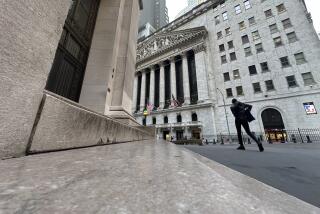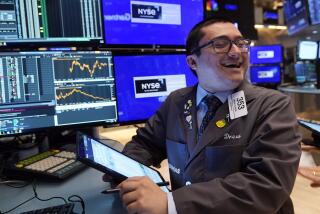Dow Dives 156 After Foreign Markets Fall : Second-Worst Day Reduces Value by 8%
NEW YORK — Jarred by headlong dives in markets from Hong Kong to London and a new wave of forced sales by individual investors, prices on jittery U.S. stock markets plunged again Monday in very heavy trading.
The widely followed Dow Jones industrial average of 30 blue-chip stocks lost 156.83 points, or 8.04% of its value, to close at 1,793.93. That point drop was the index’s second worst--after the 508-point crash of a week ago--since the index took on its current format after World War I. In percentage terms, the slide was the indicator’s sixth worst.
Trading volume on the New York Stock Exchange rose to 308.82 million shares from Friday’s 245.56 million, even though trading was halted two hours early on both days to permit overwhelmed bro-kerages to catch up on paper work. The exchange said Monday that it will extend the shortened trading hours, originally scheduled to end today, through Friday.
The American Stock Exchange and the National Assn. of Securities Dealers, which operates the over-the-counter stock market, said they would match the Big Board’s truncated hours.
American investors appeared to be spooked Monday by sharp drops in markets overseas. It was the obverse of last week’s crash, which began in New York and then moved to foreign exchanges.
On Monday, before the New York markets had opened, the Tokyo Stock Exchange’s 225-share Nikkei stock average fell 1,096.22 points, or 4.7%, in its third-worst point loss ever. In London, the Financial Times Index of 100 leading shares fell 111.1 points to 1,684.1, a loss of 6.2%.
33% Drop in Hong Kong
The worst percentage loss was in tiny Hong Kong, where authorities had closed the stock exchange from Tuesday through Friday in a fruitless attempt to stem a wave of selling. When the exchange reopened Monday after its four-day shutdown, the accumulated anxiety of investors drove its Hang Seng index down 1,120.70 points, or 33%--by far its biggest one-day drop ever.
Observers said the foreign markets were jittery about the worldwide implications of a serious recession in the United States. Investors here and abroad appeared to be unmoved by the start of deficit-reduction talks between President Reagan and congressional leaders that were called after last week’s market panic.
Adding to the pressure on U.S. markets Monday was a near-record tide of margin calls, in which investors who have borrowed against their shareholdings are ordered by lenders to put up new money to restore the collateral pared away by the market’s fall. Margin calls tend to depress prices in two ways: Investors may sell some of their shares to protect their stake in the rest, and lenders can unilaterally sell shares of holders who fail to answer their demands.
Monday’s broad slide, in which more than 13 stocks fell in price for every one that rose, had market professionals looking for signs, somewhat in vain, that the continued blow-off would soon exhaust itself.
“Once we get this catharsis over with, I think we can get ready for a move up,” said Michael Metz, market strategist for Oppenheimer & Co.
All Indicators Down
The sell-off affected all major market indicators. Among others, the New York Stock Exchange composite index closed at 127.88, down 11.34 points; the American Stock Exchange composite was down 24.34 at 239.67; and the over-the-counter index was down 29.54, at 298.91.
The crash has now pared 34.1% from the Dow Jones industrial average since it hit its peak of 2,722.42 on Aug. 25. Some bearish market analysts now predict that the index could drop as low as 1,300 before rallying.
Throughout Wall Street, brokerage houses and stock-exchange personnel continued Monday to work through the mountainous backlog of processing work created by the market’s record-breaking activity. Brokerage employees worked Saturday and Sunday to prepare for “settlement” on Monday of trades executed one week ago, the market’s worst day in history; as is the custom, money and stock certificates technically change hands on the fifth business day after the trade.
Today is the settlement day for trades done last Tuesday, when volume on the New York Stock Exchange hit its peak of 608 million shares.
Securities executives said the processing procedure for the record trading days--which one likened to “a mouse going through a snake”--was painstaking but that no rash of significant errors had been unearthed.
“There are a lot of nuisance-type difficulties, but no major cost items,” said Howard Shallcross, director of operations for Merrill Lynch & Co.
Exchange officials said the rate and number of so-called “questioned trades” had risen significantly during trading last Monday and Tuesday. Questioned trades are those in which brokers on the exchange floor and brokerage officials are in dispute, most often over the price at which a trade was executed or the number of shares involved in the order.
Some disagreements also involve the timing in which one broker’s order was filled in relation to another’s, a matter that could have a serious effect on the price at which a share was bought or sold.
Floor brokers and specialists--who are exchange brokers who function rather as auctioneers in supervising the trading in specific stocks but must also buy and sell heavily as needed when a particularly heavy inflow of orders to buy or sell threatens to unbalance the market--will receive for the first time today formal reports showing how many trades executed in the frenzied hours of last Monday and Tuesday were completed (or “cleared”) late or not at all.
Although most such trades are ultimately reconciled, temporary disputes may create passing but huge financial problems for some specialist firms, market participants say.
“Suppose you bought 100,000 shares of something from somebody and sold 100,000 to someone else,” said Robert B. Fagenson, a specialist and floor governor. “If the purchase cleared immediately but the sale took two more days, for an individual broker that could be a debilitating situation.”
Accordingly, over the weekend the NYSE arranged an open-ended credit line with the Federal Reserve Board and a group of major New York banks to cover such temporary problems.
Meanwhile, professionals involved in program trading, the computer-driven method of executing immense trades on the stock exchange floor, began stirring Monday to combat the popular view that their activity was largely responsible for last week’s crash. This position is likely to be articulated by many stock investors and stock exchange officials when hearings begin in Congress on the market’s shocking volatility.
Program trading advocates are arguing that the root cause of the plunge was not their own activity but the market’s recognition that the Reagan Administration’s deficit policies were imprudent and that stock prices had moved too high.
“Negative assertions about program trading are simplistic since they blame a market strategy while ignoring macroeconomic conditions,” complained the Chicago Mercantile Exchange, where futures contracts instrumental in program trading are bought and sold.
More to Read
Inside the business of entertainment
The Wide Shot brings you news, analysis and insights on everything from streaming wars to production — and what it all means for the future.
You may occasionally receive promotional content from the Los Angeles Times.










